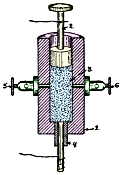Electronics & High Technology Components
- See Full List of AI Topics -

The invention and development of the coherer marked a transformative moment in
radio signal detection, facilitating the transition from theoretical studies of
electromagnetic waves to practical wireless communication. Developed in the 1890s,
the coherer is widely attributed to
Édouard Branly,
a French physicist whose experiments with metal filings in a glass tube led to a
device that could detect electromagnetic waves. His discovery showed that when exposed
to such waves, the metal particles cohered or clumped together, changing their electrical
resistance. This effect allowed a current to pass through the coherer, indicating
the presence of a radio signal.
Sir
Oliver Joseph Lodge, an English physicist, made substantial contributions by
introducing the term "coherer" and adding practical innovations, such as a "tapper"
reset mechanism, which restored the filings to their initial state, ready for the
next signal.
The coherer's construction was simple but effective. It consisted of a glass
or insulating tube, typically with two electrodes at either end, containing loosely
packed metal filings. Iron and nickel were common choices due to their conductive
properties and responsiveness to electromagnetic fields. When a radio-frequency
electromagnetic signal reached the coherer, the filings within would clump, lowering
the device's resistance and allowing a current to flow. This change was detected,
amplified, and recorded, enabling signals to be decoded. Lodge's addition of the
tapping mechanism - a small hammer or solenoid that lightly struck the tube - allowed
the filings to separate back into a loose state after each signal, which improved
the coherer's usability in continuous telegraphy.
Operating frequencies for the coherer typically fell within the low kilohertz
(kHz) to low megahertz (MHz) range, covering the long-wave frequencies employed
in early radio experiments and basic wireless communications. While the device lacked
selectivity across a wide frequency range, it could detect Morse code in simple
on-off keying (OOK) transmissions, ideal for early wireless telegraphy. However,
due to the coherer's limitations in handling complex modulations, it became best
suited to long-wave transmissions, a spectrum frequently used in early maritime
and military signaling.
Patents were instrumental in protecting and commercializing coherer technology,
though Branly did not file one himself. Instead, others, inspired by his work, secured
patents to expand the device's utility. Oliver Lodge patented several enhancements
in the United Kingdom, including improvements that made the coherer more sensitive
and resilient. He described the reset system and included additional coils to increase
its receptivity, which made the device more practical for early radio setups. Guglielmo
Marconi, who incorporated the coherer into his own experiments with wireless telegraphy,
filed patents detailing an entire coherer-based radio system, most notably his 1897
British patent No. 12039. This patent included a tuning capability that allowed
specific frequencies to be isolated, making it one of the earliest steps toward
selective tuning. Marconi's development led to broader applications, as he implemented
the coherer in maritime communications, enabling ships to send and receive messages
across vast distances, a critical advancement for both commercial and military needs.
Other inventors explored similar mechanisms that took advantage of the cohesive
properties of metallic particles in electromagnetic fields. For instance, Indian
scientist Jagadish Chandra Bose developed an "iron-mercury-iron coherer with telephone
detector," a variant that employed mercury in place of the filings to improve stability
and signal sensitivity. Bose's design showed that alternative materials and configurations
could enhance the coherer's performance, leading to his 1904 U.S. patent (No. 755,840).
Such innovations reflected an ongoing effort to improve detection capabilities and
inspired competition within the growing field of wireless technology.
As coherer technology proliferated, companies such as Marconi's Wireless Telegraph
Company and Telefunken integrated coherers into their products, using them in wireless
communication systems for both public and private sectors. While the coherer played
a central role in early radio receivers, it was eventually phased out as crystal
detectors and vacuum tubes became more sensitive and offered greater frequency selectivity.
These subsequent inventions responded to a need for devices that could handle the
increasing complexity of radio signals. However, the coherer's significance as one
of the first practical radio detectors cannot be overstated. Its invention not only
enabled early wireless communication but also established essential technological
and legal frameworks, paving the way for advancements that would define radio and
wireless communications in the 20th century.
This content was generated by the ChatGPT
artificial intelligence (AI) engine. Some review was performed to help detect and
correct any inaccuracies; however, you are encouraged to verify the information
yourself if it will be used for critical applications. In some cases, multiple solicitations
to ChatGPT were used to assimilate final content. Images and external hyperlinks
have also been added occasionally. Courts have ruled that AI-generated content is
not subject to copyright restrictions, but since I modify them, everything here
is protected by RF Cafe copyright. Your use of this data implies an agreement to
hold totally harmless Kirt Blattenberger, RF Cafe, and any and all of its assigns.
Thank you. Here are the major categories.
Electronics & High Tech
Companies | Electronics &
Tech Publications | Electronics &
Tech Pioneers | Electronics &
Tech Principles |
Tech Standards
Groups & Industry Associations |
Societal Influences on Technology
|


























